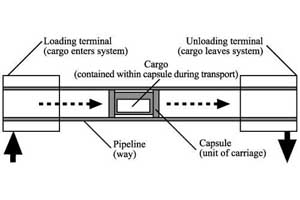Capsule pipeline transport can be defined as the movement of goods or passengers through an enclosed length of tube, in membranes which enclose the cargo.
Definition Problems
No standard definition exists. Encyclopaedia Britannica (based on Liu) is more exacting, in that capsules convey freight, and be propelled by a fluid [1]. The terms 'tube transportation' and 'tube freight' are broadly interchangeable with 'capsule pipeline'. Tube transportation has been defined as a class of transportation system in which close fitting capsules or trains of capsules move through tubes between terminals [2].
Capsule pipelines may be considered a sub-class of freight pipelines, which also include pneumatic conveying (material suspended in a gas) and slurrying (material mixed with a liquid). Capsule pipelines are least widely used of all freight pipelines.
Capsule pipelines might be differentiated from underground railways and most underground automated freight systems by the fact that in a capsule pipeline system the source of motive power is not mounted onboard the vehicle (the capsule), where as in a railway system it is normally mounted onboard the vehicle (the train). There are further grey areas involving vehicles that are sometimes designed to run within tubes, but where the core underlying technology does not require the vehicle to be contained in a tube - there is a common area of overlap here with magnetic-levitation based projects.
In practice the division between capsule pipelines and railways, automated freight or similar systems that merely run in tunnels, is difficult to accurately define.
This site tends to be focused on a core that most people would agree are 'capsule pipelines'. These are generally the areas about which there is least information available elsewhere. Underground automated freight systems and underground railways are therefore excluded from the detailed texts on this site, although you may find passing references to them.
Comparison to Other Transport Systems

A capsule pipeline as a transport system.
A capsule pipeline system is similar to many other land based transport systems. It involves a link (the pipeline) between terminals (where the item being transported enters and exits the system). A vehicle (the capsule, containing the item to be transported) moves along the link. This is shown in the figure. At this conceptual level capsule pipelines are the similar to road and rail systems.
Conventional pipelines transport either a fluid (a liquid or gas), or transport a material suspended in a fluid. Conventional pipelines are an important mode of transport, although since they are normally not visible, and do not cause many of the problems associated with other modes of transport, they tend to be ignored. Water, gas, sewage and oil are commonly transported by pipeline. Many solids can be slurried (mixed with a liquid), the material transported in suspension and then separated from the liquid on arrival at its destination. Certain solids can be suspended and transported in gas (normally air): this is referred to as pneumatic conveying.
Capsule pipeline systems differ from conventional pipelines. The item being transported is placed within a capsule. The capsule is then propelled within the pipeline. In most capsule pipelines the capsule is propelled by the force of a fluid acting on the capsule. The nature of this fluid is used to sub-define capsule pipelines. Where air (or a vacuum - absence of air) is used, the term Pneumatic Capsule Pipeline (PCP) is applied. Where water is used, Hydraulic Capsule Pipeline (HCP) is the term applied.
Notes
- Britannica.com.
- Vance, L., Mattson, P., (1994), Tube Transportation, US Dept of Transportation, Volpe National Transportation Systems Center, Feb [summary cached text].